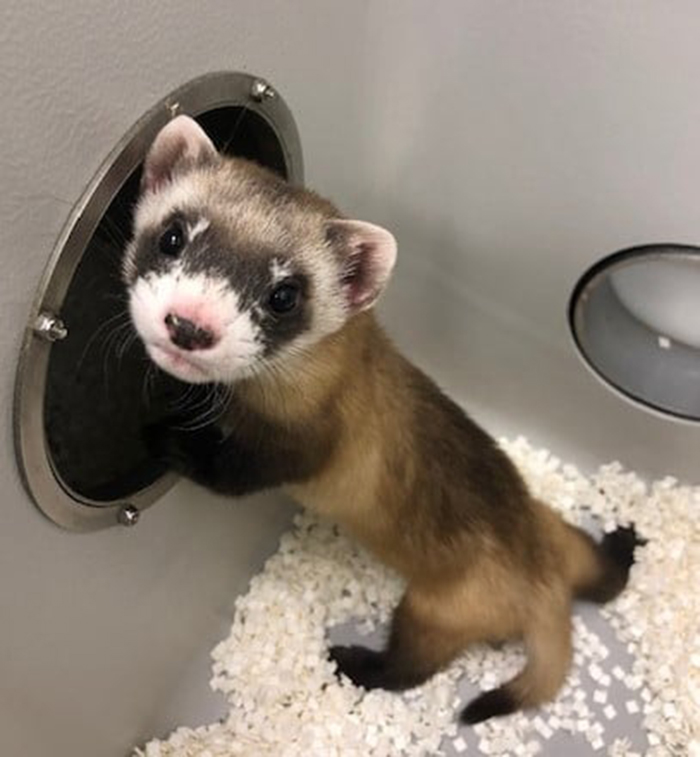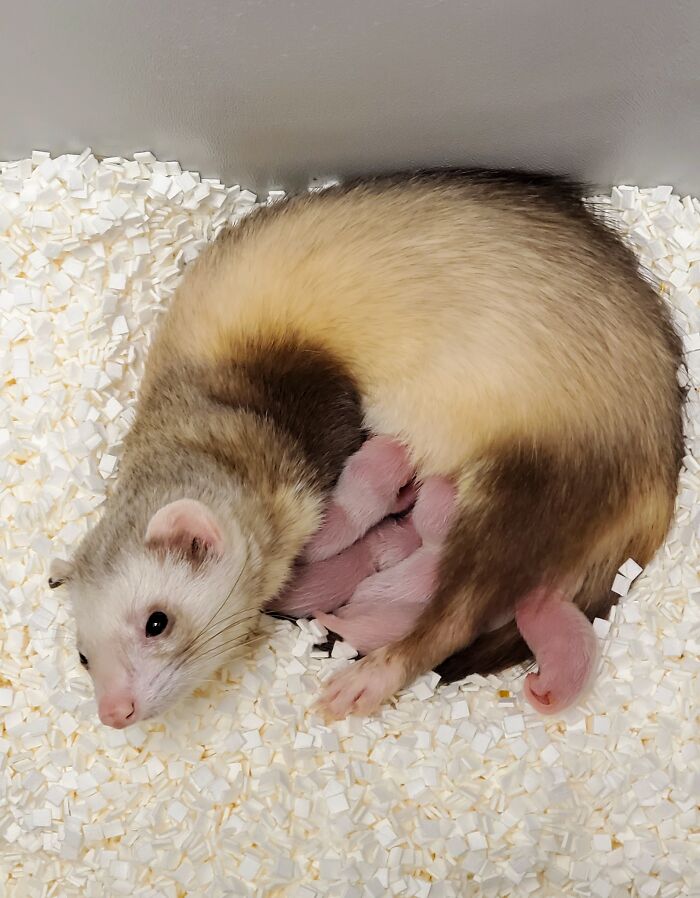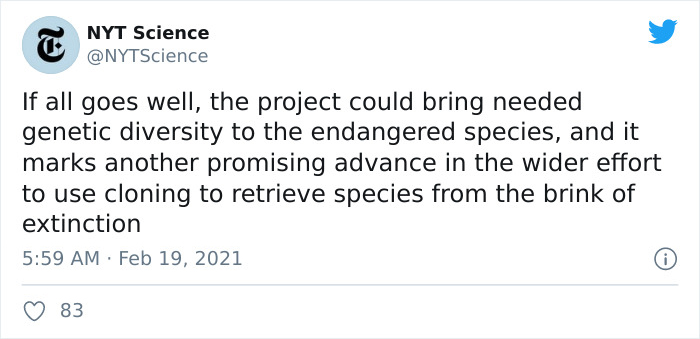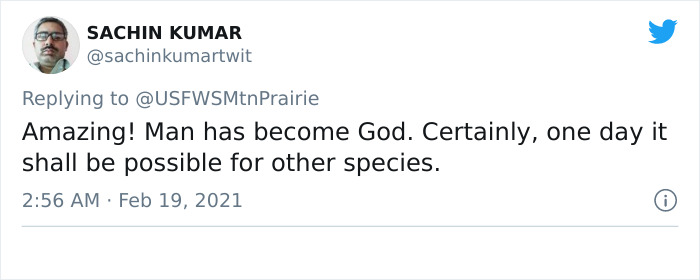
Scientists Successfully Clone A Ferret That Died In 1988, And This Might Be A Way Of Protecting Endangered Species
InterviewThe chances are you haven’t seen a black-footed ferret, also known as prairie dog hunter, because the species were thought to be extinct. Only in 1981, seven of North America’s only ferret species were found on a Wyoming ranch. Seven years later, one of the ferrets called Willa had its cells frozen following its death, as the DNA technology was first developed.
Fast forward to today and Elizabeth Ann was born using the same frozen cells taken from Willa 33 years ago. This cute little ferret arrived via C-section on December 10, and became the first-ever cloned endangered US species.
This marks a groundbreaking step in recovery of endangered species. “The birth of Elizabeth Ann could help address genetic barriers faced by many imperiled wildlife,” stated US Fish And Wildlife on Twitter.
Elizabeth Ann will not be released into the wild but instead raised in the National Black-footed Ferret Conservation Center in Colorado, so that researchers can continue to study her.
More info: Twitter | Facebook | FWS.Gov
Elizabeth Ann the black-footed ferret was cloned from the frozen cells of her ancestor Willa who died 33 years ago
Image credits: National Black-footed Ferret Conservation Center
US Fish and Wildlife has announced the wholesome news on Twitter
Image credits: USFWSMtnPrairie
The first-ever cloned endangered black-footed ferret Elizabeth Ann was brought to life by this domestic ferret mom
Image credits: USFWSMtnPrairie
To find out more about the significance of cloning the black-footed ferret, Bored Panda reached out to Joe Szuszwalak, the Public Affairs Specialist at the US Fish & Wildlife Service.
Joe told us that the project was born from collaborative efforts of the US Fish & Wildlife Service and recovery partners and scientists at Revive & Restore, ViaGen Pets & Equine, San Diego Zoo Global, and the Association of Zoos and Aquariums. Their aim was to “explore solutions to genetic diversity challenges and disease resistance for black-footed ferrets using the latest advancements in genetic research.”
Image credits: USFWSMtnPrairie
Image credits: USFWSMtnPrairie
Image credits: Revive & Restore
“The first significant milestone of this ongoing partnership occurred on December 10, 2020, with the birth of ‘Elizabeth Ann,’ created from the frozen cells of ‘Willa,’ a black-footed ferret that lived more than 30 years ago.”
Joe explained that once thought to be extinct and currently listed as an endangered species, black-footed ferrets were brought back from nearly vanishing forever by the US Fish and Wildlife Service and its partners after a Wyoming rancher discovered a small population on his land in 1981.
It turns out that ferrets from this population were captured by the Wyoming Game & Fish Department and others to begin a captive breeding program to recover the species.“This small number of individuals has put limitations on the species’ genetic diversity, creating challenges for resiliency to changing environments and emerging disease threats.”
Elizabeth Ann’s successful genetic cloning gives hope to other endangered species around the world
Image credits: USFWSMtnPrairie
Image credits: USFWSMtnPrairie
Meanwhile, “Willa, a black-footed ferret captured among the last wild individuals, has no living descendants and is therefore not one of the seven founders.”
In order to make Willa’s cloning possible, “The Wyoming Game & Fish Department had the foresight to preserve her genes and sent tissue samples from Willa to San Diego Zoo Global’s Frozen Zoo in 1988.” The Frozen Zoo established a cell culture and stewarded these precious frozen cells ever since and it “made today’s achievement possible,” said Joe.
The cloned ferret arrived via C-section on December 10, making it a groundbreaking moment in the history of endangered species recovery
Image credits: Revive & Restore
Image credits: Revive & Restore
In 2018, the US Fish and Wildlife Service issued the first-ever recovery permit for cloning research of an endangered species, allowing Revive & Restore to initiate genetic analyses and proof of concept trials. This work builds upon recent advancements in cloning processes developed by ViaGen Pets & Equine, which successfully created embryos from the frozen cell line and implanted them into a domestic ferret surrogate.
The surrogate mother was transferred from ViaGen Pets & Equine to the US Fish and Wildlife Service’s National Black-Footed Ferret Conservation Center (NBFFCC) mid-gestation to give birth to the cloned kit under the US Fish and Wildlife Service’s authority.
“This research is still in the early stages, and researchers continue to closely monitor the young kit for viability and other developments. Elizabeth Ann and her surrogate mother are kept separate from other breeding black-footed ferrets, and she will live her life at the NBFFCC as additional research is completed,” Joe explained.
But there are no plans to release this adorable furry ball into the wild
Image credits: USFWSMtnPrairie
Additional footage of the lovely Elizabeth Anne. 🙂 pic.twitter.com/fz7HnwyI1F
— US Fish and Wildlife (@USFWSMtnPrairie) February 18, 2021
Image credits: Inside Edition
Elizabeth Ann’s birth marks a groundbreaking step in species conservation. Joe explained that “Today, all black-footed ferrets are descended from seven individuals, resulting in unique genetic challenges to recovering this species. Cloning may help address significant genetic diversity and disease resilience barriers to support habitat conservation and reestablishment of additional populations in the wild.”
“But without an appropriate amount of genetic diversity, a species often becomes more susceptible to diseases and genetic abnormalities, as well as limited adaptability to conditions in the wild and a decreased fertility rate. Limited genetic diversity makes it extremely difficult to fully recover a species,” he commented.
If the project goes well, this would be a promising advancement in retrieving species that are on the brink of extinction
Image credits: NYTScience
And this is what people had to comment on it
Image credits: JackBaddams
Image credits: joe_finder
Even though this particular project was focused on addressing a specific genetic diversity concern associated with the black-footed ferret and it’s still in the preliminary stages, “the US Fish and Wildlife Service views this new potential tool as one of many available to help recover the species while also working to address habitat and other challenges to recovery.”
Yet, Joe added that “We are not currently engaged in genetic cloning efforts for any other species.”
Image credits: chadroussan
Image credits: SimonAt15432407
Image credits: TrishHerps4Life
Image credits: sachinkumartwit
Image credits: ResidingCynic
18Kviews
Share on FacebookHey! We could do dinosaurs too! And then we could put them in some kind of park and turn it into an attraction. I can't think of anything that could go wrong.
Just be sure they're all females, to be 110% sure nothing's gonna go wrong.
Load More Replies...Another chance? With the fast-paced destruction of our planet??? Even your children/ grandchildren won't get a chance.
Load More Replies...I hope they've been saving tissue samples from those almost-extinct rhino (eg Northern White). If there are preserved samples from even the last ten or twenty, it might be possible to reestablish a breeding population within a few decades.
Deborah, without a restoration and protection of the wild, what can those cloning and breeding efforts accomplish? Destruction of the wide, wild lands (which is happening on a massive scale) means not only loss of wildlife habitat but also fueling emergence of new deadly, and ever more potent viruses.
Load More Replies...Hey! We could do dinosaurs too! And then we could put them in some kind of park and turn it into an attraction. I can't think of anything that could go wrong.
Just be sure they're all females, to be 110% sure nothing's gonna go wrong.
Load More Replies...Another chance? With the fast-paced destruction of our planet??? Even your children/ grandchildren won't get a chance.
Load More Replies...I hope they've been saving tissue samples from those almost-extinct rhino (eg Northern White). If there are preserved samples from even the last ten or twenty, it might be possible to reestablish a breeding population within a few decades.
Deborah, without a restoration and protection of the wild, what can those cloning and breeding efforts accomplish? Destruction of the wide, wild lands (which is happening on a massive scale) means not only loss of wildlife habitat but also fueling emergence of new deadly, and ever more potent viruses.
Load More Replies...






















243
45